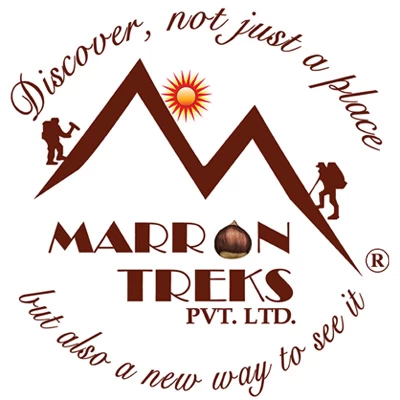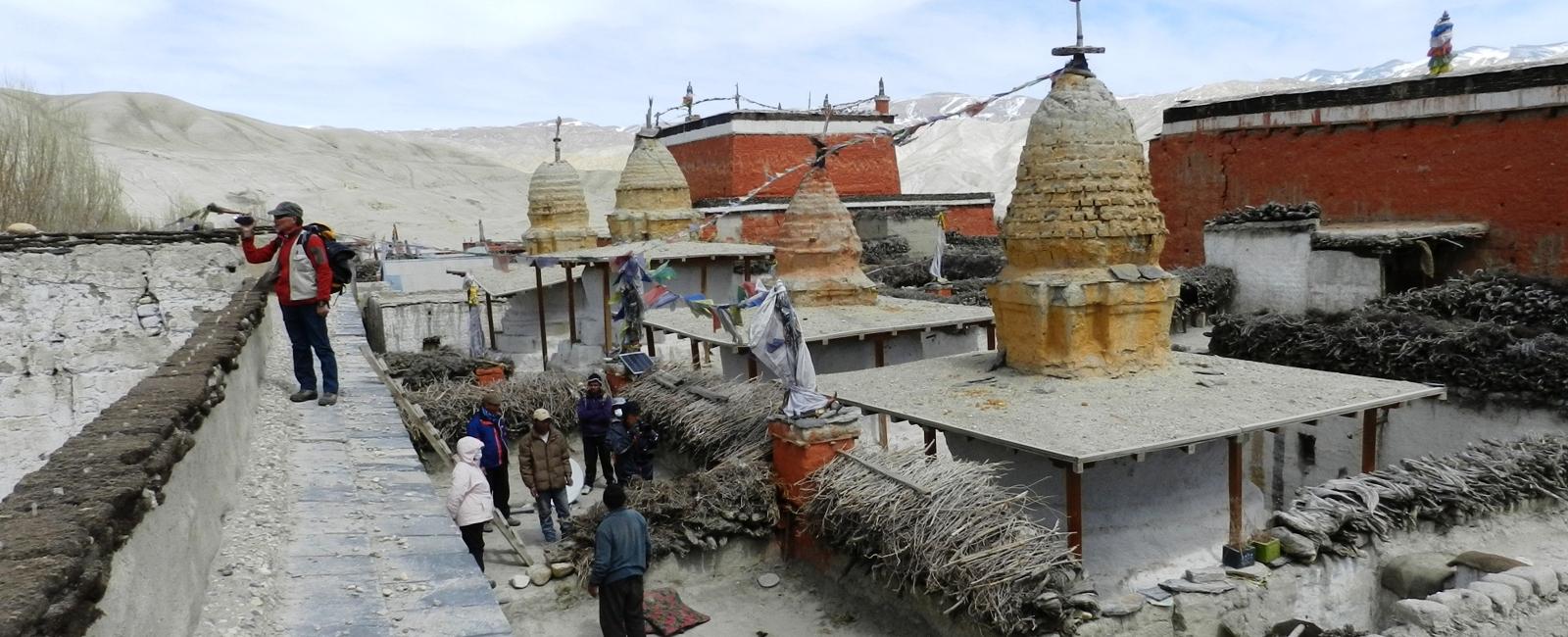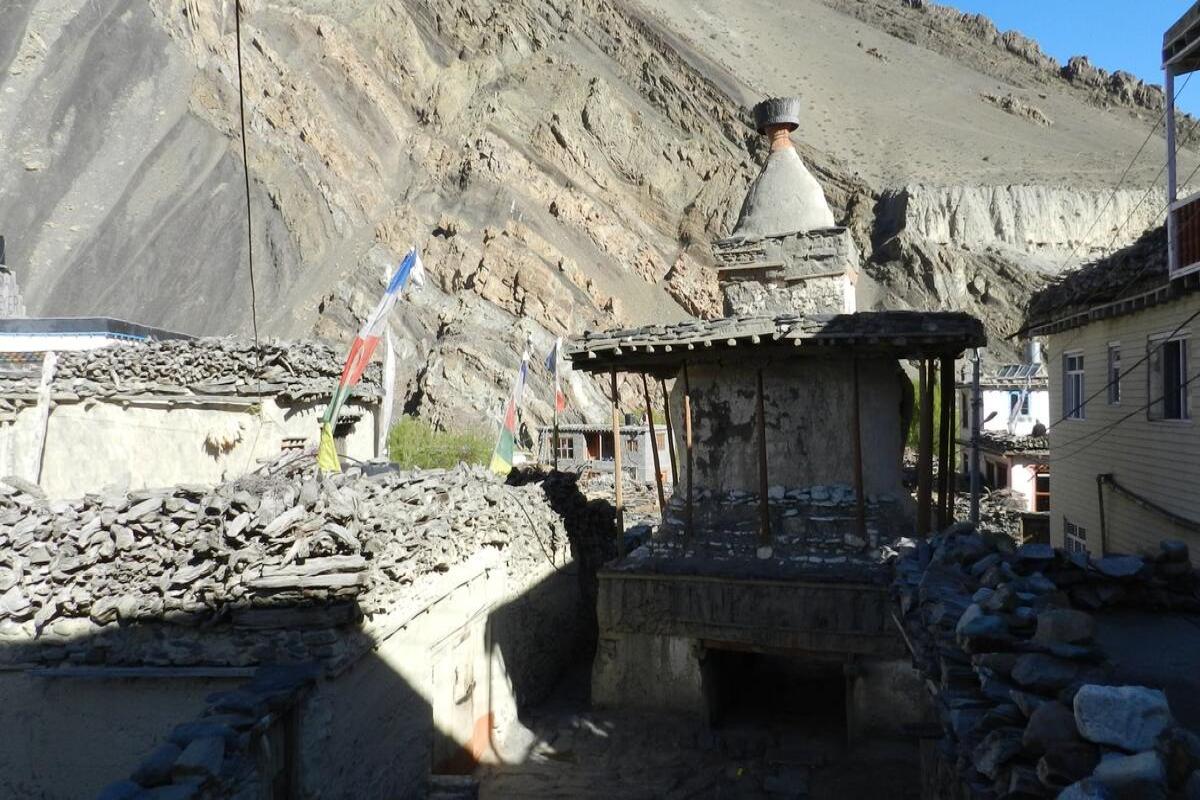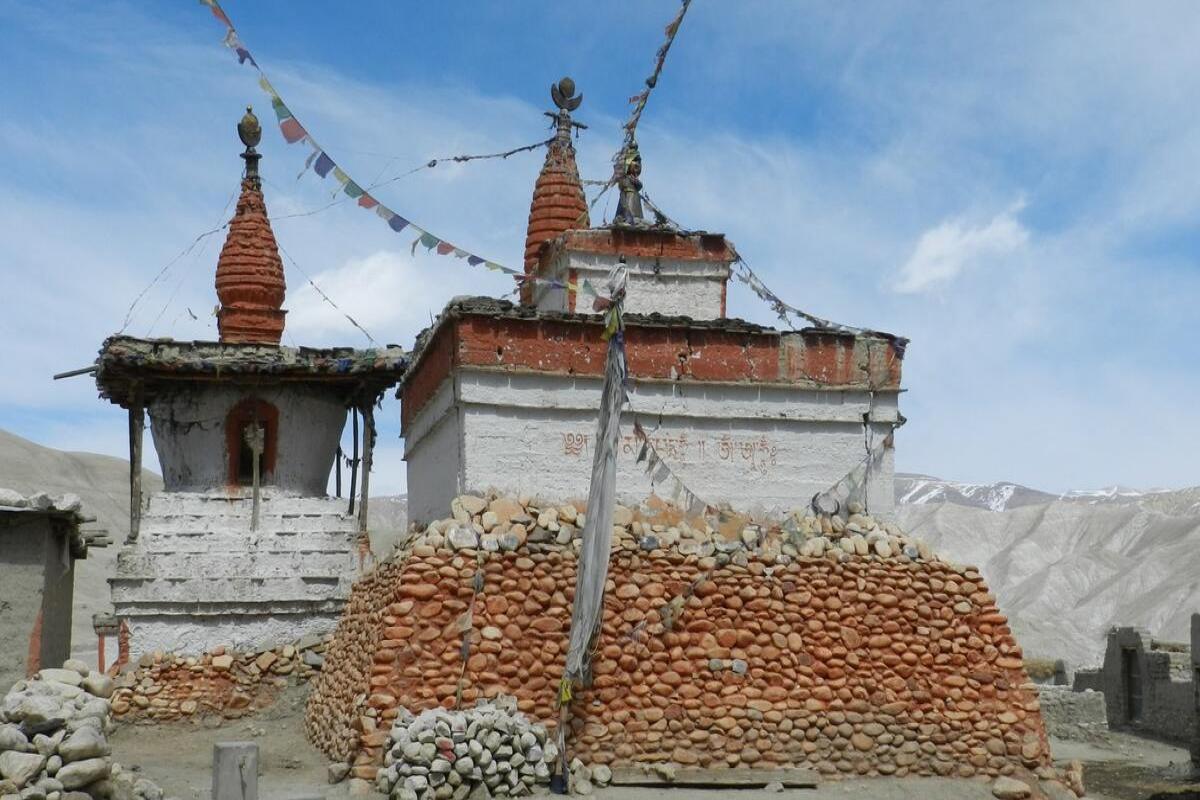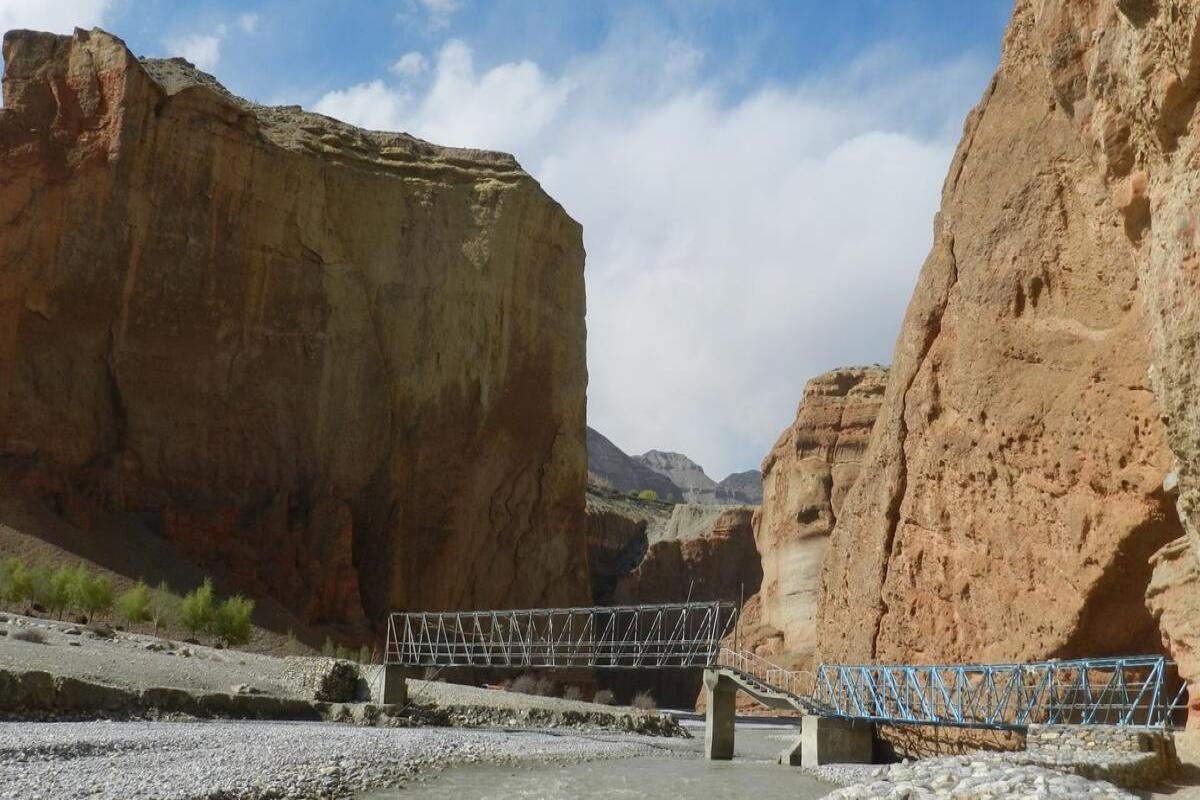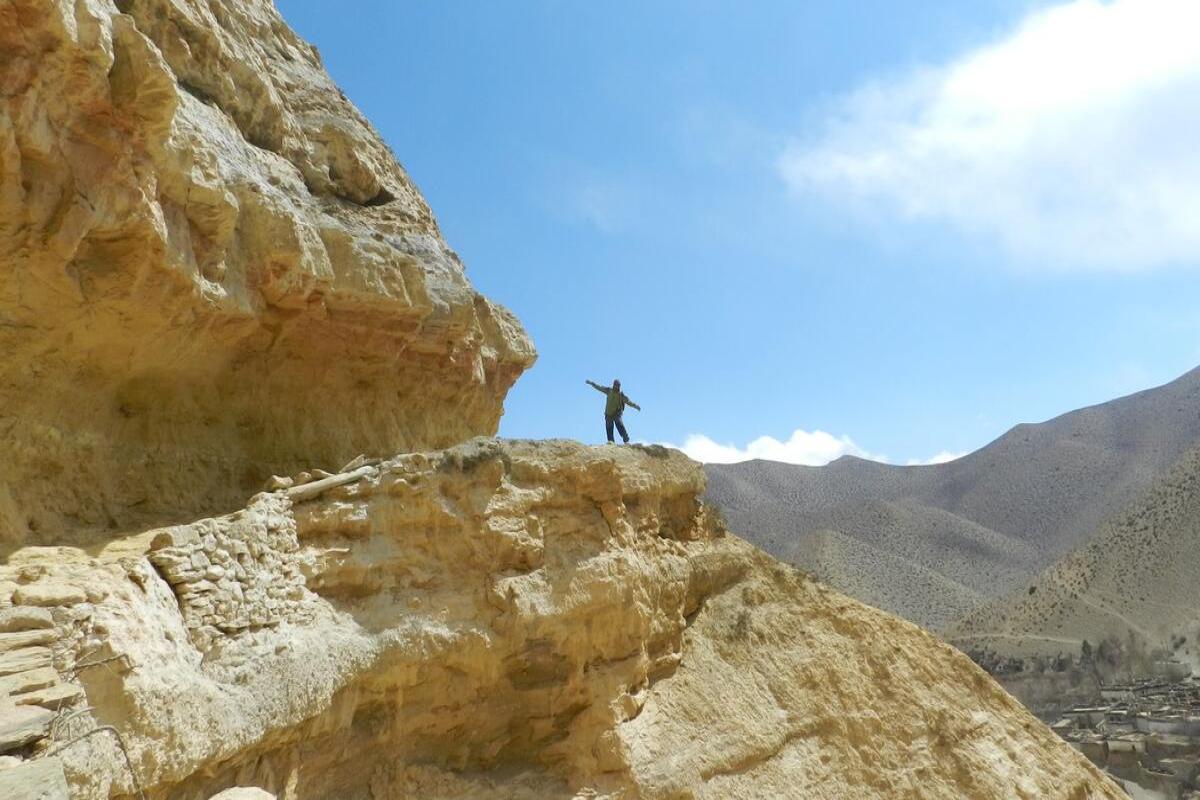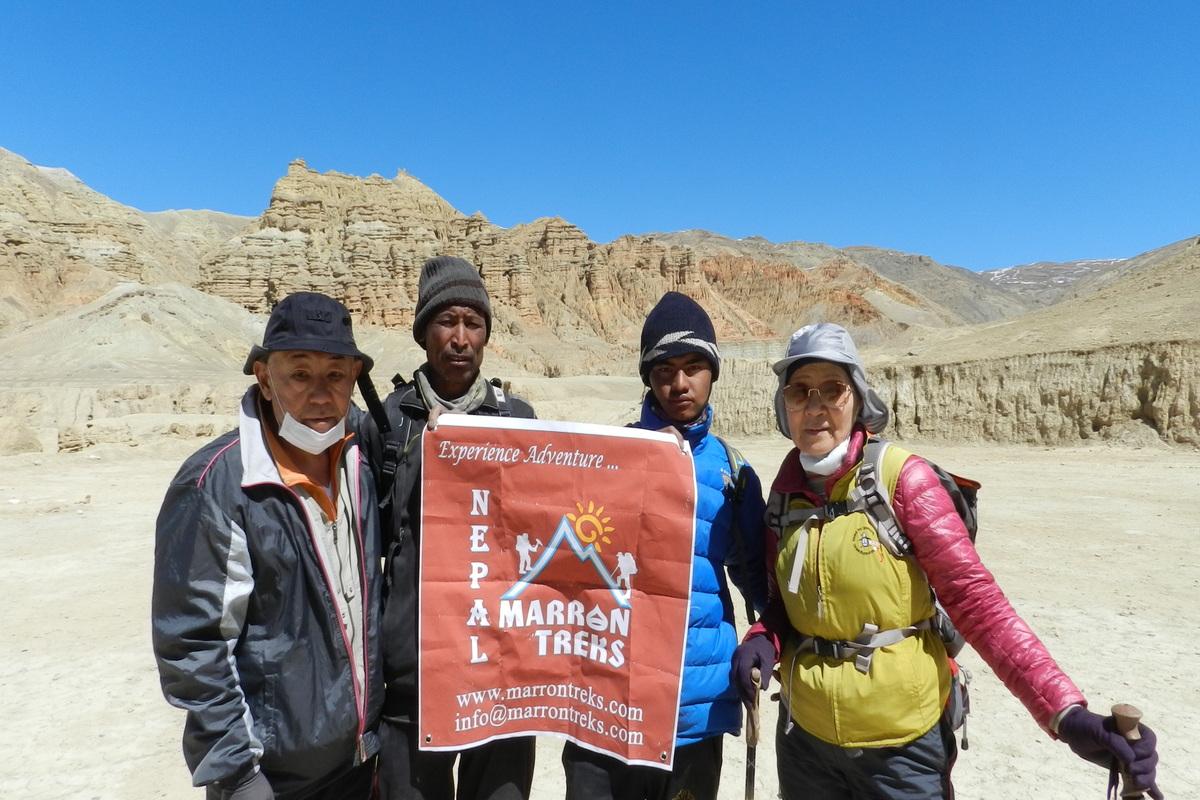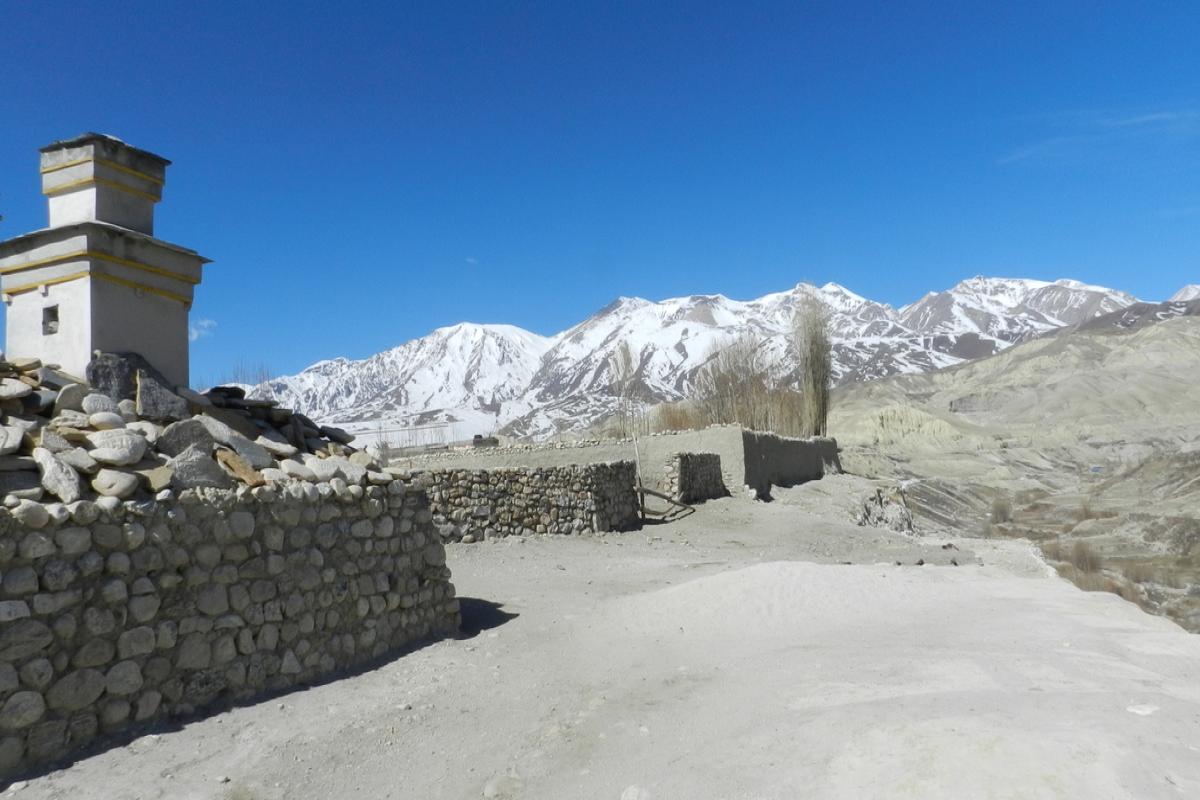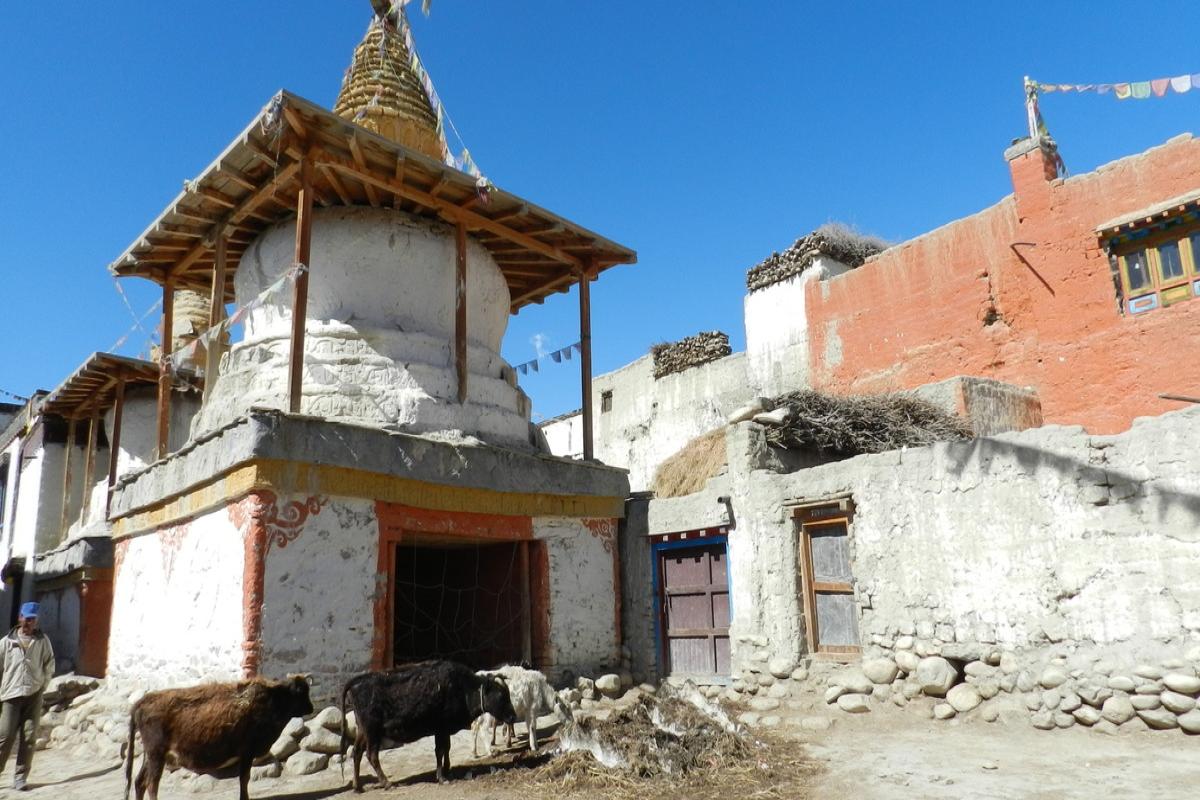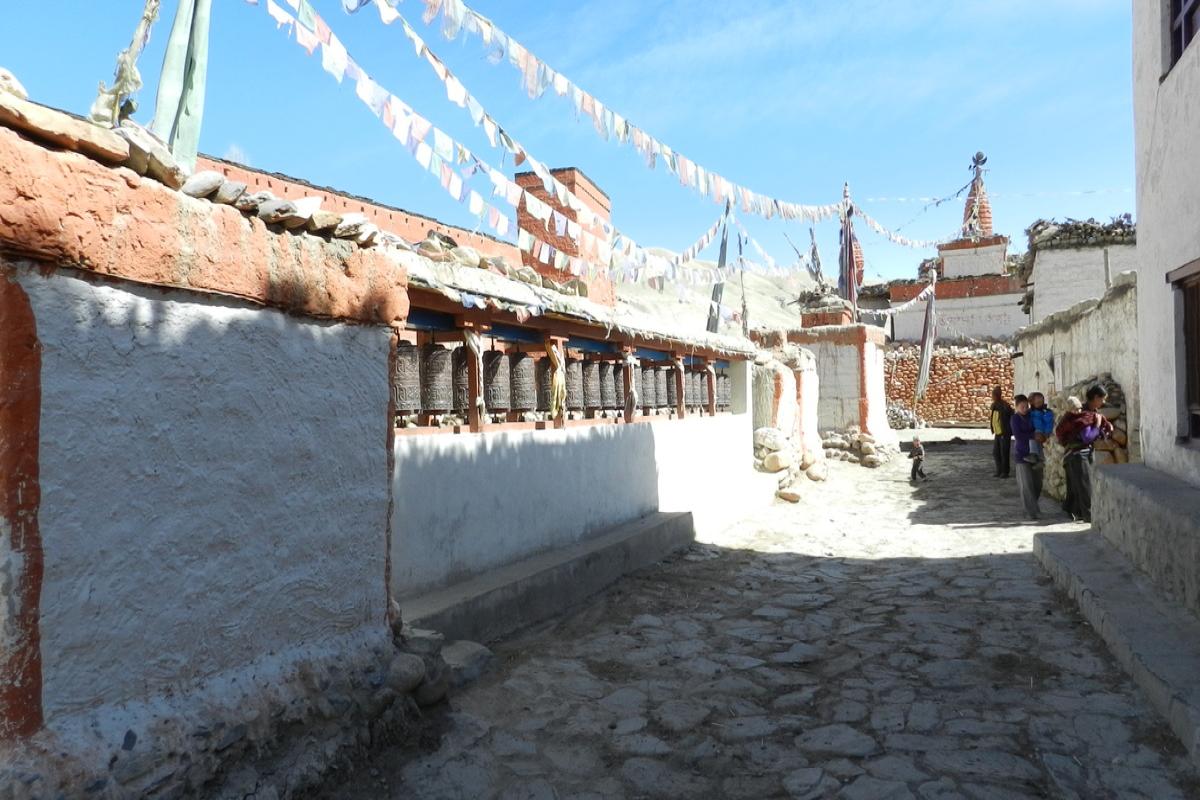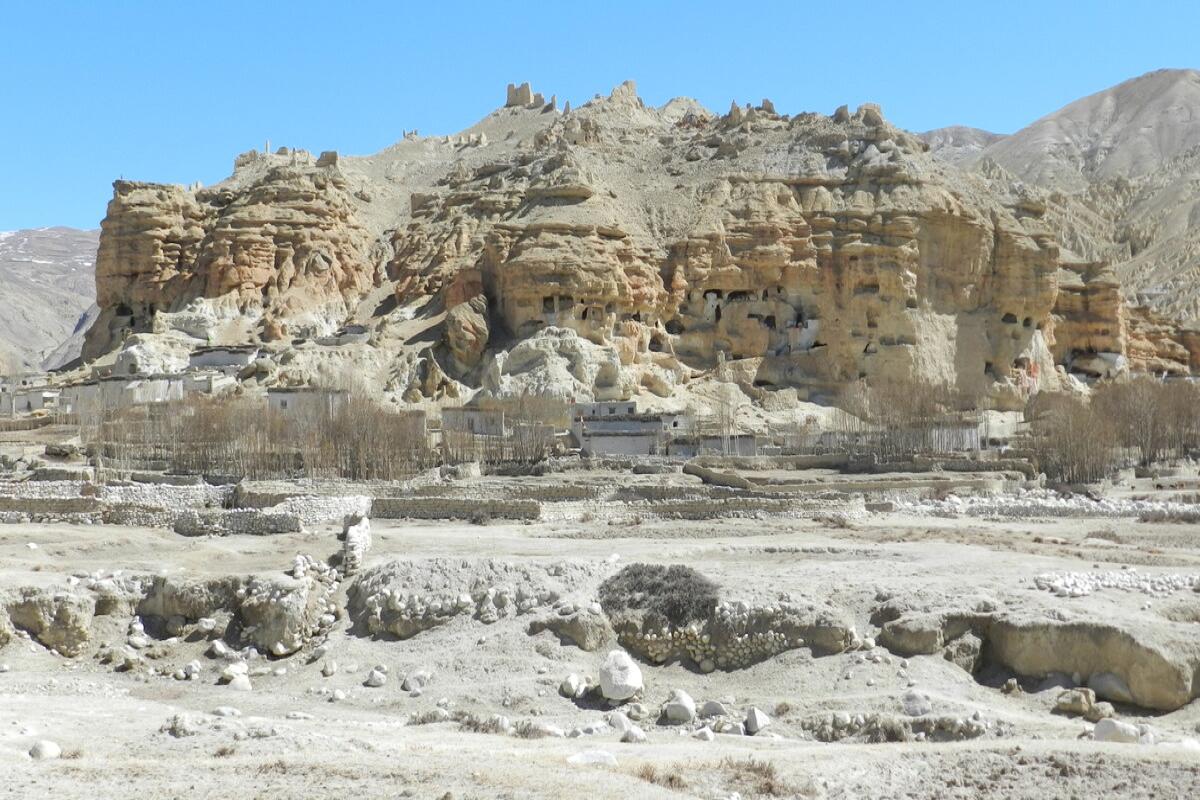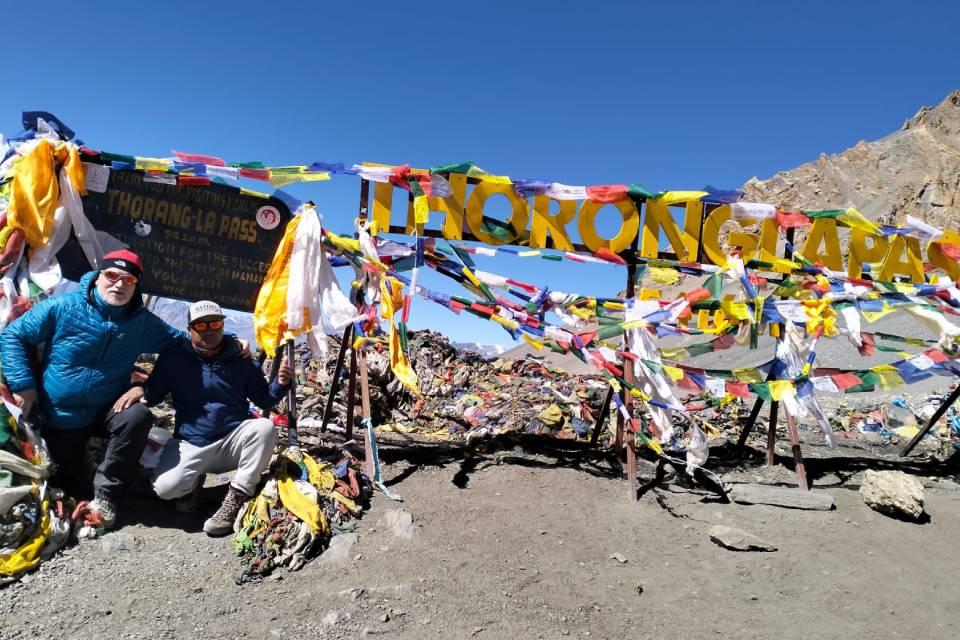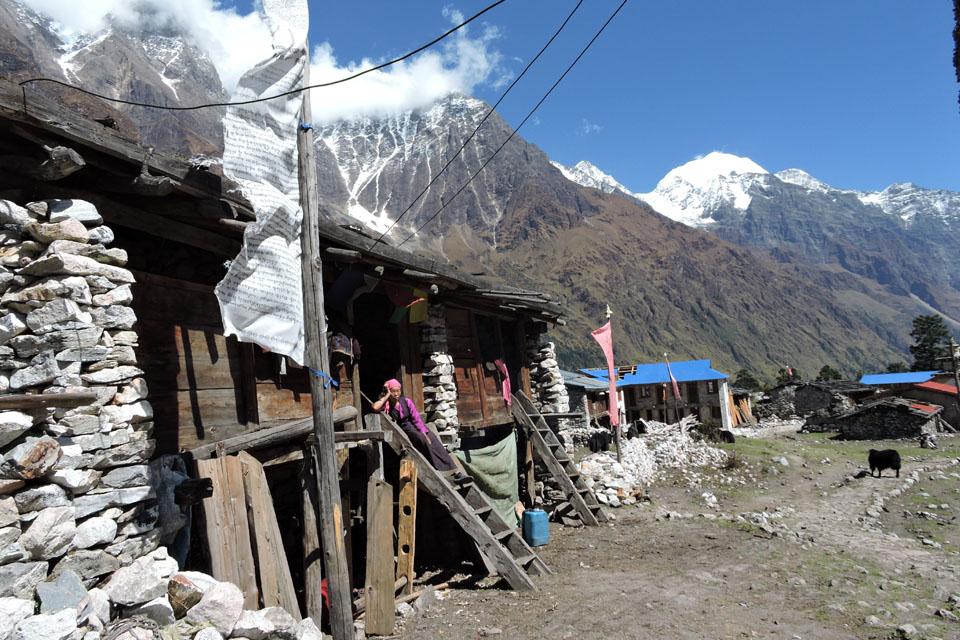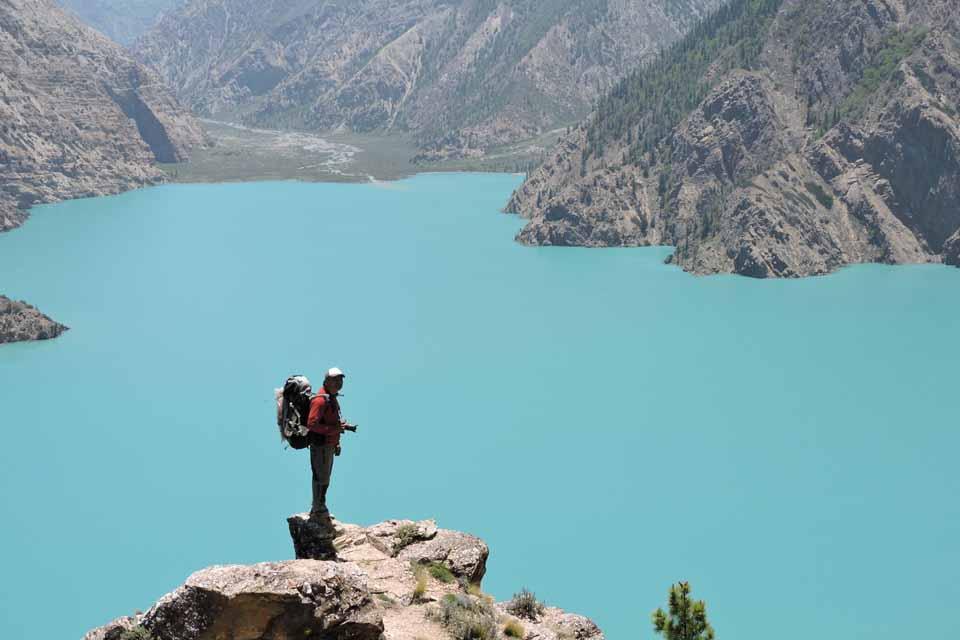Upper Mustang Trek
Trip at a Glance
Upper Mustang often also called ‘the forbidden Kingdom’ is a remote and isolated region in the Himalayas of Nepal, located near the Tibetan border. Upper Mustang trek is a popular trek to the remote and restricted region of Nepal offering a unique cultural experience and stunning scenery. Trekking to the Upper Mustang was allowed and open to foreign trekkers only in 1992.
Upper Mustang trek will take you to the ancient kingdom of Mustang at Lo Manthang situated at 3,730 meters. Lo Manthang is the ancient capital of Mustang and is a beautifully preserved walled city where people still live even to this day. The Tibet Autonomous Region of China is located towards the northern border of the city whereas Dalome Rural Municipality of Mustang is in the south.
The trekking trail of Upper Mustang passes along traditional villages, age-old Buddhist monasteries and ancient caves, all set against the backdrop of the spectacular Himalayan mountains. Witness the traditional way of life of the local people who are of Tibetan descent, as you hike along to the ancient walled city of Lo Manthang.
Upper Mustang trek starts after a scenic short flight to Jomsom from Pokhara then you need to trek to Kagbeni following the Kali Gandaki River Valley. Thereon the trail passes through beautiful traditional mountain villages, barren cliffs, and windy valleys, offering panoramic views of the surrounding snow-capped mountains like Nilgiri, Annapurna, and Dhaulagiri.
Eventually, you will reach the ancient and popular walled city of Lo Manthang. Explore around the city where time has stood still for ages visiting it’s age-old Buddhist monasteries like the Namgyal Gompa, King’s palaces and the narrow streets and alleyways. To make is even more interesting you can take a hike to the mysterious Jhong cave in Chhoser about 2 hours walk from Lo-Manthang. They are often called sky caves located on hillsides, which are multi-story man made caves attracting archaeologists from around the world.
Upper Mustang Trek is an exclusive journey and culturally rich travel experience in the Himalayas offering a glimpse into a hidden region of Nepal with remarkable scenery, ancient culture, and an astonishing Himalayan panorama.
Upper Mustang Trek Highlights
- A scenic flight to Jomsom with the splendid views of Dhaulagiri and Annapurna mountains simultaneously.
- Discover the picturesque northern Himalayan region of Nepal, its multifarious landscapes & its diverse range of floras and faunas.
- Visit Kagbeni, a gateway to the restricted zone of Mustang and a major trading route between India & Tibet.
- Explore Lo Manthang with it’s age-old Buddhist monasteries & ancient caves.
- Plentiful cultural encounters with the ethnic people of Tibetan descent.
Itinerary
Day 01: Arrival in Kathmandu (1400m)
Day 02: Drive or fly from Kathmandu to Pokhara
Day 03: Fly from Pokhara to Jomsom (2743m) & trek to Kagbeni (2800m/3 – 4 hours)
Day 04: Trek from Kagbeni to Chele (3050m/5 – 6hours)
Day 05: Trek from Chele to Geling (3510m/7-8 hours)
Day 06: Trek from Geling to Charang (3570m/7–8 hours)
Day 07: Trek from Charang to Lo Manthang (3810m/5 hours)
Day 08: Excursion day in Lo Manthang (3810m)
Day 09: Trek from Lo Manthang to Ghemi (3490m) via Lo Gekar (3822m/5 – 6 hours)
Day 10: Trek from Ghemi to Samar (3150m/5 – 6 hours)
Day 11: Trek from Samar to Kagbeni (2800m/6 – 7hours)
Day 12: Trek from Kagbeni to Jomsom (2743m/3 – 4hours)
Day 13: Fly from Jomsom to Pokhara (820m/20min)
Day 14: Drive or fly back from Pokhara to Kathmandu
Day 15: Final departure
Upon arrival at the Tribhuwan International Airport in Kathmandu, you need to accomplish your entry/visa formalities. You will then be received by a representative from Marron Treks and transferred to your hotel in Kathmandu. Welcome drinks will be served at the hotel and then we will have a quick pre-trip meeting. You can then spend the remaining time resting or as you please. In the evening you can stroll around the vicinity of your hotel just to get the feel of this wonderful city.
Flying is the quickest option, taking around 25 minutes compared to several hours by road. The flight offers stunning views of the Himalayas, including the Annapurna and Langtang ranges. The road journey is longer (6-7 hrs) but allows you to experience the scenic beauty of the countryside. The Prithvi Highway offers picturesque views.
We will take an early morning flight from Pokhara to Jomsom. The breathtaking 35 minutes on board tosses us above the Kali Gandaki gorge, the world’s deepest. The towering snowcapped peaks of Dhaulagiri and Annapurna stand formidably adjacent to us as we peek through the small glass windows of our aircraft. Not just that, looking underneath, the views of waterfalls, canyons, and terraced fields are simply magnificent. This is truly one of the world’s most spectacular scenic flights! Upon arrival at Jomsom, we’ll meet the rest of our trekking staff for lunch. Today, we commence our trek on a fairly easy section of the trail, following the Kali Gandaki River to Kagbeni, which happens to be the gateway to the restricted zone of Mustang and one of the major trading routes between Tibet and India . The traders brought salt from Tibet and barley, spices and clothes from India . After the Chinese invasion of Tibet , trade came to a halt and many of the rich villages lost their revenue, subsequently causing the number of inhabitants to dwindle. Nowadays, though some trade has resumed, majority of the village income comes from tourism. According to a legend, while entering this dusty settlement, we should only think about the good things, quitting all bad thoughts outside the town gate.
From Kagbeni to Tangbe (3020m), the trail winds along the east riverbank and occasionally ventures out into the rocky river bed. Initially, the trail climbs steeply to the top of the hill but we’ll be rewarded with a spectacular view of prayer flags, stupas, and villages. After crossing several windblown plains and passing through a canyon, we arrive at the Mustang village of Tanbe . This small village is filled with whitewashed adobe houses nestled against each other and is surrounded by beautifully terraced fields of wheat, barley, and buckwheat, as well as small apple orchards. On the lower side of Tangbe, we’ll see three elegant chortens and the remnants of an old abandoned fort. As we continue our walk, be on the lookout for black ammonites, small fossils of coiled sea molluscs that inhabited the Tethys Sea and covered the Tibetan plateau millions of years before the Himalayas were formed. They are considered to be holy by many local people. Continue on to Chaile.
From Chele we make a fairly steep climb to a cairn at about 3150m, which offers a great view of “Gyagar village” across the canyon. The trail, which is literally carved into the side of this spectacular canyon, continually renders scenic retreats. We cross a mountain pass, and then make a long gradual descent along a pleasant trail to Samar. Finally, after passing through several small canyons that are home to cool streams and shady juniper trees, we arrive at Geling (3510m). This largest village before entering Upper Mustang is a rarely visited gem, set among numerous poplar groves and a central stream, housing one of the oldest Gompas of the region. Spend the evening relaxing in front of the central field, where you can observe the grain being threshed, animals grazing, and children playing.
From Geling, the trail climbs gently through fields of barley and groves of poplar trees up the center of the valley, passing below the settlement of Tama Gaun and an imposing chorten. After rejoining the direct trail, it becomes a steep slow climb across the head of the valley to the Nyi La pass at 4020m, the highest point reached on the trek. Charang is a maze of fields, willow trees and houses separated by stone walls at the top of the large Charang Cho Canyon . The huge five story white dzong and red gompa are perched on the edge of the Kali Gandagi gorge on the east end of the valley.
Today we’ll move slowly but steadly up a rocky trail to a cairn on a ridge opposite the village at 11,841 feet. The trail turns north and climbs gently to a large isolated chorten that marks the boundary between Charang and Lo. After a rest break we’ll travel across a desert-like landscape painted in every hue of grey and yellow.. Finally, we reach our destination- the whitewashed walls of the city of Lo , which sits among fields filled with horses and yaks.
This is a well earned rest cum an excursion day at one of the most mystique regions. We explore the surrounding areas visiting the Namgyal Gompa and Tingkhar. Namgyal Gompa, situated on a hilltop, serves as an important monastery of the local community and also as a local court. After visiting Namgyal Gompa, we proceed towards Tingkhar, the last major settlement to the northwest of Lo-Manthang. Fully content with these enticing explorations, we hike back to our teahouse.
The other viable options for excursions at Lo Manthang could be visiting some of the attractive landmarks like- the astoundingly tall Champa Lhakhang (God house), the red Thugchen Gompa, Chyodi Gompa, and the four- storey building of the King’s palace.
We have the opportunity to vary our return route and visit two villages that we did not see on the trek northwards. At Ghemi we’ll visit Gar Gompa, the oldest archive gompa in Nepal . Ghemi is also known for its many hectares of beautiful fields and for its white- washed houses. The trail to Lo Gekar is not a main trading route and is crisscrossed with herder’s trails, so our local guide is particularly useful here. Today’s trek will cross several valleys, some lush and others barren. Near the end of the hike the trail then makes a long rocky descent down a ravine to a grassy valley, where Lo Gekar is situated within a group of large trees by a stream. Lo Gekar, which means “Pure Virtue of Lo,” is also known as Ghar Gompa, or”House Temple”.
The moment we kiss goodbye to Ghemi, we embark on a constricted path and continue thereon until we reach Geling. We then cross a small stream and finally arrive at Samar, a village that literally emanates the Tibetan way of life.
Trek from Samar to Kagbeni is frequented by descents. We trail along a downhill route and arrive at Chhuksang (2920m). Crossing the suspension bridge over the roaring Kali Gandaki River, we continue walking along the bank of the river relishing the view of apple orchards and natural vegetation alongside, until we finally get to Kagbeni, a typical, stone built Mustang village. Its history dates back to the 14th century when it was formed as a check post for traders of Nepal and Tibet. This checkpoint still exists and is in operation, controlling the groups departing towards Muktinath and Mustang. It is also the main entry/exit point to the restricted area of Upper Mustang. The village has a monastery, a Police check post and ACAP (Annapurna conservation area project) office.
Trek from Kagbeni to Jomsom is fairly flat and along the riverbed. We trail along the banks of Kali Gandaki and pass through the settlement of Eklebhatti before we finally arrive at Jomsom. The last trek and the shortest one of course!
We take a scenic 20 minutes’ morning flight from Jomsom to Pokhara. The flight from Jomsom to Pokhara is relatively short but offers breathtaking views of the Himalayan mountains, including the Annapurna and Dhaulagiri ranges. Make sure to have your camera ready! Once in Pokhara, take advantage of the various attractions it has to offer. You can visit Phewa Lake, Devi's Fall, Gupteshwor Cave, and enjoy the beautiful surroundings.
After beakfast, either take a flight to Kathmandu or go for an overland drive back to Kathmandu.
Final departure: Today is your final day in Nepal. It is advisable to reach the airport three hours prior to your flight. A representative of Marron Treks will escort you to the airport for your final departure. If you wish to extend your trip, we have other adventurous tour packages like Bungy Jumping, Mountain Biking, Jungle Safari, White Water Rafting, Golfing & Paragliding etc. Please let us know about your desire for trip extension so that we can make the necessary arrangements.
What is included?
- Airport pick-up and drop services.
- Hotel accommodations in Kathmandu & Pokhara with breakfast.
- Kathmandu/Pokhara/Kathmandu transfers by private vehicle or tourist bus.
- Pokhara/Jomsom/Pokhara round airfares.
- All trekking accommodations with Breakfast/Lunch/Dinner at local lodges.
- Four seasonal sleeping bags (to be returned after trip completion) & Marron Treks duffel bags.
- A comprehensive medical kit (will be carried by the trekking guide).
- Experienced Government licensed English Speaking Guide & Porter (1 porter for two people) including their food, accommodation, salary & insurance.
- Permits for Annapurna Conservation Area, TIMS (Trekkers' Information Management System) & Special Upper Mustang Permit (US$ 500 per person).
- Farewell dinner with a live Nepalese cultural program.
- All government and local taxes.
What is not included?
- International airfare
- Nepal entry visa fee – Visa can be obtained upon your arrival at the Tribhuwan International Airport in Kathmandu. (USD30 for 15 days)
- Lunch & dinner in Kathmandu or Pokhara
- Personal travel insurance.
- Emergency rescue evacuation (to be covered by the client's travel insurance).
- Excess baggage charges (luggage allowance for domestic airlines in Nepal is 15 kgs.)
- Other expenses of a personal nature (phone calls, laundry, battery recharge, extra porters, bottle or boiled water, hot shower etc.)
- Cost incurred due to the addition of extra days or change in the itinerary due to bad weather, political turmoil or any other unforeseen contingencies.
- Bar bills, alcoholic drinks & beverages.
- Tips for Guide & porters
Route Map
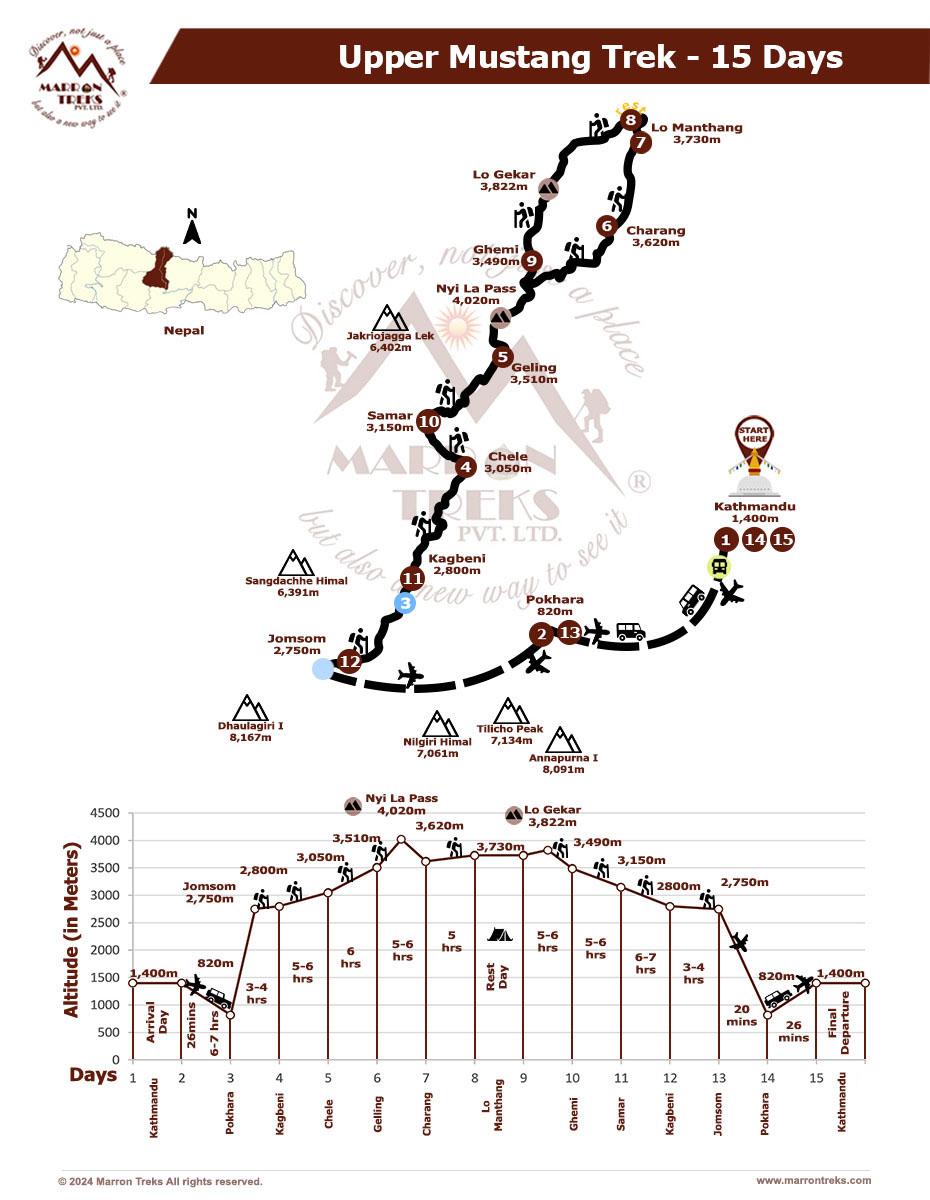
Trip Info
Accommodation
While you are in Kathmandu, we opt to accommodate you in 4- or 5-star hotels like Hotel Royal Singhi (4-star), Hotel Manaslu (4-star), Radisson (5-star), Yak & Yeti (5-star), or similar. During the trek, you will be accommodated in a local mountain lodge, better known as Tea House. These lodges and teahouses provide good services and are equipped with basic amenities. We will endeavor to provide you with the best accommodation available along the route so that you get a good night’s rest in a hygienic milieu.
Meals
We never compromise the quality of food or the health of the trekkers as well as the crew members. Generally, we opt for the fresh and nutritional local community food available. You could make your delicious pick from an array of traditional foods like Sweet potatoes, buckwheat barley, etc. This way, you could not only get a real sense of the local culture and life patterns but also contribute to promoting the locally available resources of organic food and beverages. Besides, a wide range of Continental, Chinese, Italian and Indian cuisines like Pizza, Spaghetti, French Fries, Soups, Breads, Masala curry, etc. are also available in the restaurants for your retreat.
Acclimatization
Altitude sickness is a serious risk while trekking in the Himalayas. It's important to acclimatize properly by spending a few days at lower altitudes before heading higher. By spending time at lower altitudes before pushing higher, your body has time to adjust. Our trekking packages have enough acclimatization days planned where you'll be spending a day or two at lower altitudes, allowing your body to adjust to the increasing altitude.
Electricity & drinking water
For an additional cost, you can use the electricity in all tea houses and lodges to recharge your batteries. The lodges have packaged mineral water for sale, or you can fill your bottle with boiling water. To make water drinkable, you can use water purification tablets too. But, due to hygienic issues, you should avoid drinking water from taps, rivers, or wells in trekking areas.
Communication
At lodges, restaurants, and hotels, Wi-Fi is available for an additional fee in the most popular trek regions, like Everest, and Annapurna. However, at high elevations, phone calls are the only means of connection. Our office in Kathmandu is in constant communication with your trek guide. In Kathmandu, you can purchase a local sim card for communication purposes. At high elevations, the mobile signal might not be as strong, though.
Luggage
Our porters are paired with one trekker for every two hikers, and one porter can safely carry 30 kg maximum weight. Therefore, we advise you to fill your duffle bag not more than 15 kg with your belongings. You may carry a small backpack with your valuables and informational documents. The things you are not taking along on the trek can be stored in a hotel in Kathmandu free of cost.
Typical Trek Day
Mostly your trek day starts with breakfast at 7-8 am, followed by a 3-4 hour morning trek. Lunch break is around an hour, then you continue trekking to your destination for the day. After reaching the teahouse lodge, you can relax, explore nearby areas, and enjoy dinner at 6-7 pm. Evenings involve socializing, a trek briefing, and leisure activities before bed.
Travel Insurance
It is advised that you arrange your travel insurance before leaving your homeland. The main thing is to make sure that your insurance covers you for both- medical and evacuation costs. Having travel insurance with you makes your trip secure and hassle-free.
Our Guides
Guides play a significant role during the trek. They are the ones who literally decipher the trekking codes for you so that you can actually connect with nature, culture and people along the way. We have helpful and dedicated trekking guides who are very well-versed in the culture, life patterns and every single detail pertaining to the trek region you are traveling in. Thus, in the company of our professional Sherpa guides, your trek becomes not only entertaining but also equally informative.
Porter and Staff Care
When it comes to high-altitude trekking, porters and staff members make up a pivot. Marron Treks ensures that all the porters and staff members going to high altitudes are provided with adequate clothing and equipment. All our field staff are covered by insurance.
